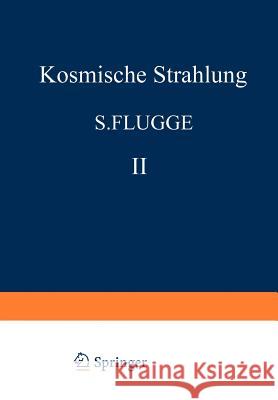Kosmische Strahlung II / Cosmic Rays II » książka



Kosmische Strahlung II / Cosmic Rays II
ISBN-13: 9783642460814 / Angielski / Miękka / 2012 / 654 str.
Kosmische Strahlung II / Cosmic Rays II
ISBN-13: 9783642460814 / Angielski / Miękka / 2012 / 654 str.
(netto: 383,36 VAT: 5%)
Najniższa cena z 30 dni: 385,52
ok. 22 dni roboczych
Dostawa w 2026 r.
Darmowa dostawa!
Theory of Cascade Showers.- A. Introduction.- B. The elementary processes.- I. Corrections to the Bethe-Heitler formula.- II. Radiation length and critical energy.- C. The diffusion equations for electron showers, and the limitations of the approximations.- I. The diffusion equations.- II. Limitations of the approximations.- D. Behaviour of the shower functions and elementary solutions.- E. One-dimensional electron shower theory.- I. Shower functions in Approximation A.- II. Shower functions in Approximation B.- III. Solution in other approximations.- F. Three-dimensional electron shower theory.- I. Three-dimensional electron shower theory in the Landau approximation.- II. Three-dimensional electron shower theory without the Landau approximation.- III. Behaviour of the structure function and its numerical evaluation.- G. Application of the theory to the shower phenomena.- References.- Cosmic Rays and High-Energy Physics.- I. Discovery of multiple production.- II. Direct observations of high-energy interactions.- III. Behaviour of high-energy cosmic rays.- IV. Models of multiple production.- V. Summary of cosmic-ray information.- References.- The Spectrum and Charge Composition of the Primary Cosmic Radiation.- I. Introduction.- II. Solar influences on the spectrum.- a) Solar produced changes in the total radiation.- b) Solar produced changes in the proton component.- c) Solar produced changes in the helium component.- d) Solar produced changes in the S nuclei (Z?6).- e) From a spectrum of the solar modulation.- III. Spectrum of the total radiation.- a) Primary spectrum derived from ion chamber and counter measurements in the latitude sensitive region.- b) Primary spectrum at energies of 100–1000 GeV derived from the spectrum of ?-rays at high altitudes.- c) Primary 1014 eV/Nuc.- XII. Detailed charge features of the radiation.- a) Isotopic composition of the primary radiation.- XIII. A comparison of the spectra of the different charge groups.- a) Charge composition at energies > 1014 eV.- b) Spectra at energies < 3 × 109 eV.- c) Effects of solar modulation on the low energy end of the spectrum.- XIV. Astrophysical consequences of the above results in relation to the acceleration and propagation of cosmic rays.- a) Propagation of the primary radiation in the galaxy.- b) The process of acceleration and escape from the source region.- c) Source regions for primary cosmic rays.- References.- High Energy Photons and Neutrinos from Cosmic Sources.- I. Introduction.- II. Production in the interstellar gas, the galactic halo, and the intergalactic medium.- a) Meson production in cosmic ray nuclear collisions.- b) The electron production spectrum.- c) Electron energy losses in the galaxy.- d) Electron production and energy losses in the intergalactic medium.- e) The electron energy spectrum in the halo and intergalactic medium.- f) High energy photon flux from various processes.- g) Comparison with observations.- h) Tests of cosmological theories.- III. Discrete sources of high energy photons.- a) General summary of the observations.- b) Possible galactic sources.- c) Mechanisms for x-ray production in discrete sources.- d) The Crab nebula.- e) The galactic center.- f) Solar system sources.- g) Hard radiation from stellar coronae.- h) Extragalactic discrete sources.- IV. Neutrino sources.- V. Conclusion.- References.- The Time Variations of the Cosmic Ray Intensity.- I. Introduction.- II. Geophysical effects of cosmic radiation.- a) Geomagnetic threshold rigidities.- b) Effect of magnetic fields due to external current systems.- c) Asymptotic directions and the analysis of anisotropies in the incident particle flux.- d) Specific yield functions.- III. Experimental evidence on the modulation mechanism.- a) Cosmic ray time variation.- b) Solar energetic particles.- IV. Modulation mechanisms.- a) Introductory survey.- b) Modulation by regular magnetic fields.- c) Modulation by disordered magnetic fields.- d) Summary.- References.- Nukleonen in der Atmosphäre.- A. Einleitung.- B. Die Primärkomponente der kosmischen Strahlung.- C. Kernwechselwirkungen der Nukleonen-Komponente in der Atmosphäre.- D. Protonen in der Atmosphäre.- E. Neutronen in der Atmosphäre.- a) Direktmessungen.- b) Sterne in Kernemulsion.- c) Neutronen-Monitor.- d) Neutronenmessungen (direkt und indirekt) mit speziellen kosmischen Strahlungsspektrographen.- e) Die Winkelverteilung schneller Neutronen.- f) Neutronenproduktion und C14-Produktion durch solare Protonen.- g) Verlustfluß im Sonnenfleckenzyklus. (Theoretische Ergebnisse.).- h) Experimentelle Verlustfluß-Intensitäten.- i) Aperiodisch emittierter Verlustfluß. (Solare Teilcheneinbrüche.).- Anhang 1: Kosmische Strahlung — Registrierstationen.- Anhang 2: Das Erdmagnetfeld; geomagnetische Koordinaten; spezielle Wahl.- Literatur.- Cosmic Ray Produced Radioactivity on the Earth.- A. Introduction.- B. Corpuscular radiation.- I. Primary particles.- II. Propagation of cosmic radiation in the atmosphere.- C. Production of isotopes in the atmosphere.- I. Methods of evaluating the source functions.- II. Altitude and latitude distribution of nuclear disintegrations in the atmosphere.- III. Rates of production of isotopes in the atmosphere.- IV. Time variations in isotope production.- V. Global averages of nuclear disintegrations and of isotope production in the atmosphere.- VI. Possible additional sources of isotopes in the earth’s atmosphere.- D. Terrestrial isotopes of non-atmospheric origin.- I. Production of isotopes in the lithosphere.- II. Accretion of isotopes contained in extraterrestrial matter.- E. Circulation of isotopes in the geosphere.- I. Dispersion of isotopes in the atmosphere and fall-out.- II. Introduction of isotopes into the deep ocean.- III. Conservation laws for a system of well mixed reservoirs.- IV. The distribution of isotopes in the principal terrestrial reservoirs.- V. The applicability of various isotopes to the study of particular geophysical processes.- F. Some important observations on cosmic ray produced radio nuclides in the geosphere.- I. Global inventory studies.- II. Studies in the atmosphere.- III. Oceanographic studies.- IV. Studies in the biosphere.- G. Appendix.- References.- Effects of Cosmic Rays on Meteorites.- Course of radiation in a meteorite.- History of meteorites.- Secular equilibrium.- Time variations.- Meteorite samples.- Measurement.- Cosmic-ray age.- Production rates.- Recovered artificial satellites.- References.- Sachverzeichnis (Deutch-Englisch).- Subject Index (English-German).
1997-2025 DolnySlask.com Agencja Internetowa
KrainaKsiazek.PL - Księgarnia Internetowa









